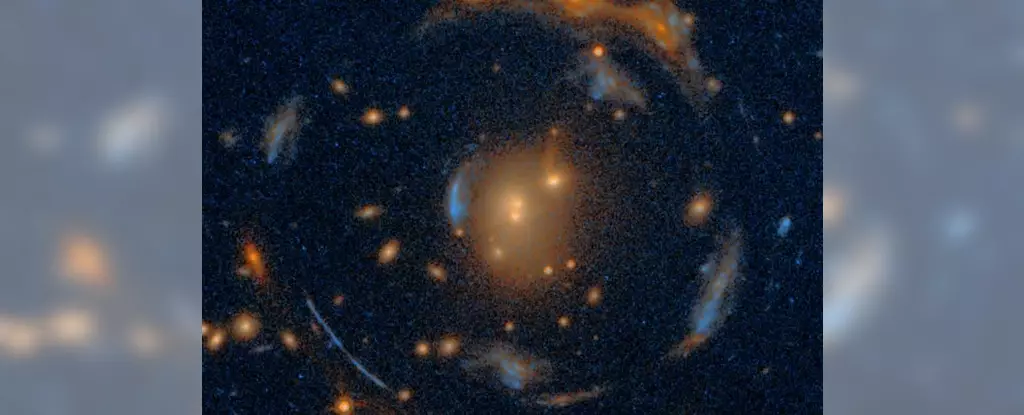Astrophysics often presents us with phenomena that challenge our understanding of the universe. Among these, gravitational lenses act as cosmic funhouse mirrors, altering our view of distant celestial bodies while simultaneously providing a wealth of information about the elusive structures of galaxies and quasars that lie beyond them. Recently, a team of astronomers utilizing the Hubble Space Telescope (HST) unveiled a captivating image of a gravitational lens referred to as “The Carousel Lens.” This remarkable alignment showcases seven background galaxies distorted by an intervening galaxy cluster, signaling significant implications for the study of cosmology.
A Rare Alignment of Cosmic Objects
The Carousel Lens emerged from data obtained through the Dark Energy Survey, which has been instrumental in uncovering the intricacies of the universe. Renowned Berkeley Lab senior scientist David Schlegel emphasized the serendipitous nature of this discovery, describing it as a “galactic line-up” that serves as a unique gateway into the depths of cosmic exploration. He asserts that while discovering one gravitational lens is akin to finding a needle in a haystack, uncovering an arrangement as complex as the Carousel Lens is like seeing multiple needles perfectly aligned within that haystack.
At a first glance, the Carousel Lens captivates observers with its aesthetic allure, but it is the scientific potential that truly defines its significance. The lens comprises a foreground galaxy cluster approximately 5 billion light-years from Earth. This cluster acts as a gravitational magnifying glass, allowing astronomers to observe seven other distant galaxies that range from 7.62 to 12 billion light-years away. Each of these galaxies appears distorted due to the immense gravitational forces acting upon them, creating an array of images and shapes—a phenomenon analogous to funhouse mirrors that morph reflections.
In the world of gravitational lensing, two primary classifications exist: strong and weak lenses. The Carousel Lens falls firmly into the realm of strong lenses, a category known for producing vivid distortions of background galaxies. Essential to this phenomenon is the alignment between the foreground lensing object and the background sources. The alignment within Carousel Lens is particularly noteworthy, as its multiple galaxies display intricate arrangements that evoke images of a carousel, hence the name.
The specific configuration of the Carousel Lens presents various lensing types, including arcs and symmetrical structures, revealing the richness of gravitational effects. For instance, one collection of galaxies—designated as “4a, 4b, 4c, and 4d”—demonstrates a near-perfect Einstein Cross, indicative of the symmetrical mass distribution within the lensing galaxy cluster. This reinforces the concept that the cosmos holds a multitude of unexplored pathways and anomalies, each offering clues to understanding the universe’s foundational elements.
Scientists like Xiaoshang Huang, a member of the research team at Berkeley, emphasize the Carousel Lens’s role as an invaluable tool in deciphering the dynamics of dark matter and energy in cosmic structures. The galaxy’s formation and behavior hold critical clues about the matter distribution within the lensing cluster and its surrounding regions. By analyzing more than seven lensed sources, the researchers aim to refine their understanding of both baryonic and dark matter, which are essential to constructing a comprehensive image of the cosmos.
Besides matter distribution, the investigation into the characteristics of the distant galaxies themselves provides a unique perspective on the conditions that shaped earlier epochs of cosmic history. The case of the seventh source, which appears as a high-redshift galaxy, can illuminate processes such as “early galaxy quenching.” This phenomenon refers to the cessation of star formation in galaxies, potentially resulting from feedback interactions between supermassive black holes and their host galaxies. The implications of such discoveries extend far beyond the Carousel Lens, enriching our understanding of galaxy evolution and cosmic interactions throughout history.
The discovery of the Carousel Lens underscores the profound capabilities of modern astronomy to reveal the hidden complexities of the universe. By interpreting the bizarre images and formations produced by gravitational lensing, scientists are equipped to delve into exciting areas of research that focus on dark matter, galaxy formation, and cosmological development. As researchers continue to investigate these cosmic phenomena, they broaden the scope of our knowledge about the universe’s intricate structure and the events that shaped its evolution, anchoring hopes for future revelations yet to come. In this light, the Carousel Lens serves as both a whimsical display of cosmic artistry and a critical tool for unveiling the mysteries of our universe.


Leave a Reply